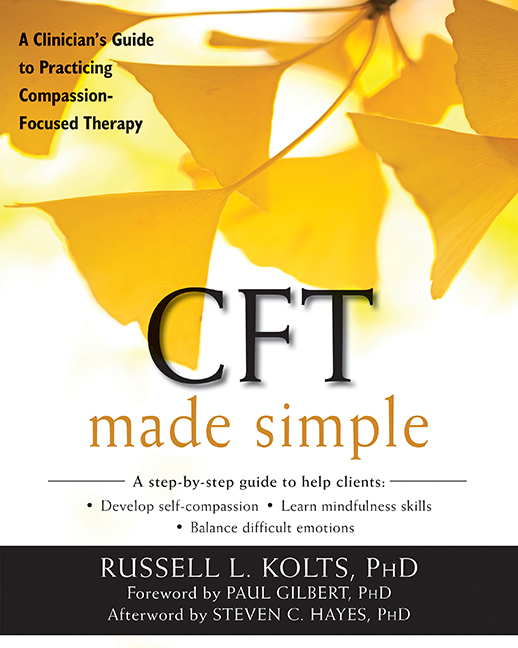Compassion-Focused Therapy (CFT) is rooted in a scientific explanation of how our brains have become the way they are through the history of human evolution. From this foundational understanding, CFT focuses on the purposeful cultivation of compassion, the skills and strengths that flow from it, and how to use them to work effectively with human suffering.
In order to cultivate compassion in clients, CFT therapists primarily focus on two things; mindful awareness, and the cultivation of compassionate ways of thinking. Helping clients relate to their thoughts mindfully involves nonjudgmental noticing and accepting thoughts as mental activity without getting caught up in clinging to them or pushing them away. Then, therapists focus on the purposeful cultivation of compassionate ways of thinking, reasoning, and understanding, which are by nature validating, soothing, encouraging, and skillfully focused on working with suffering.
In order to help clients learn the skills needed to approach pain, struggle and suffering in a compassionate way, therapists focus on the cultivation of six attributes that are geared toward developing compassionate courage. After all, the willingness to approach and work with the really difficult things takes bravery.
In his book, CFT Made Simple: A Clinician’s Guide to Practicing Compassion-Focused Therapy, clinical psychologist Russell Kolts, PhD explores the six attributes. The following have been adapted from the book.
1. Sensitivity
Sensitivity is a core component of compassion. In this context, it refers to helping clients open their awareness to experiences of pain, suffering, struggle, and difficulty. This radical openness may stand in contrast to the avoidance that has perhaps characterized the way they typically cope with the things that challenge them. Sensitivity involves noticing these experiences, so that clients can learn to actively and purposefully attend to them. This allows the possibility of being moved by them.
2. Sympathy
The sensitivity of compassion isn’t a cold awareness that things aren’t as we’d prefer them. It is infused with warmth—containing a felt connection to the being that suffers, whether that being is us or someone else. Sympathy involves feeling a bit of heartbreak for the being that is suffering, so that ultimately we are moved by their suffering.
This sympathy stands in stark contrast to the self-criticism an shame that clients often bring to therapy. It involves a softening of self-to-self and self-to-other relating. When clients are able to stop self-attacking and allowing themselves to be moved by their own suffering and the suffering of others, they often gain the motivation to face and work with their suffering, even when they know it won’t be easy.
With compassion, we are moved, and we want to help.
3. Compassionate Motivation
The sincere motivation to help prevent or alleviate suffering is also a core component of compassion. We accept and engage willingly with suffering, but we don’t wallow in it. By helping clients develop compassionate motivation, we help them develop the motivation and courage to approach suffering with a specific intent—to understand the suffering and the causes and conditions that lead to it. This allows them to engage in helpful activity to help alleviate or prevent it.
The idea here is to help clients strengthen and learn to shift into a caregiving social mentality, so that rather than be consumed by feelings of threat, their attention, thinking, motivation, and behavior are focused on helping themselves and others. This motivation can give rise to the courage to face difficulties head-on.
“This caring motivation isn’t something we’re manufacturing from scratch—we’re working to awaken our clients’ natural capacity for caregiving and nurturance that evolved with our mammalian ancestors, enabling them to face tremendous hardship and danger to ensure the survival of their young,” writes Kolts.
4. Distress Tolerance
In order to work directly and actively with suffering and the factors that lead to it, clients and therapists must have the ability to tolerate distress. As we know from other therapy models, this is a capacity that can be cultivated.
In CFT, distress tolerance involves both the willingness to endure discomfort and the cultivation of the ability to self-soothe—to help ourselves feel safe and to make life a bit easier when there is pain that must be endured as we approach and work with suffering.
5. Nonjudgment
Compassion involves the ability to relate to one’s experience in accepting, nonjudgmental ways. Through the cultivation of compassion, clients learn to replace the judging, labeling, and self-blame that often accompany difficult experiences with a compassionate awareness that seeks to understand these experiences.
6. Empathy
Whereas sympathy involves being moved by suffering, empathy involves making efforts to understand the suffering as it exists from the perspective of the being that suffers. As clinicians, we want to help clients look deeply at the range of emotions arising within themselves and others. We want them to ask themselves: What am I actually feeling? How does it makes sense that I might be feeling this way? Having suspended judgment, compassion seeks to understand emotional experience.
All together, these six attributes form a powerful orientation toward suffering, which unfolds from awareness to action.
“With compassion, we notice suffering, we are moved by it, and we want to help. In order to do this, we must work to tolerate distress, and to nonjudgmental and empathically understand the causes and conditions that contribute to the suffering and difficulty,” writes Kolts.
 For more about compassion-focused therapy, check out CFT Made Simple.
For more about compassion-focused therapy, check out CFT Made Simple.


 2024 Peace Playbook: 3 Tactics to Avoid Clashes with Your Partner
2024 Peace Playbook: 3 Tactics to Avoid Clashes with Your Partner